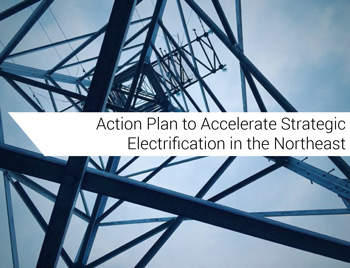
By Dave Hewitt | Mon, May 27, 19
In 2018, NEEP developed an Action Plan to Accelerate Strategic Electrification in the Northeast. The plan came out of an extensive process that included an ongoing steering committee, the production of a regional resource assessment, and a two day conference with over 100 people.
At the technology level, the plan included both electric vehicles as well as building decarbonization. At the policy level, sometimes the same policies can work for a variety of technical solutions. For example, time-of-day electricity rates can support both EVs for overnight (or peak solar production) charging as well as heat pump water heaters.
While it certainly is time for action, some of the excellent suggestions for research are also critical, for both broad purposes like education and detailed critical purposes such as optimizing the levels of energy efficiency to build into space heating electrification in buildings. A few of these research items fall within the types of activities that NEEP undertakes, but more of them require some type of specialized expertise and separate funding to complete.
 Below is a list of some research ideas that came out of that extensive process – with some comments regarding where the Northeast is one year after publication of the initial action plan.
Below is a list of some research ideas that came out of that extensive process – with some comments regarding where the Northeast is one year after publication of the initial action plan.
- Conduct detailed economic research on the regional impacts of strategic electrification on at-risk jobs, job creation, and the economy.
This is still a number one priority, as I believe the economic impacts for a region that largely imports its fossil fuels will be very positive. Job impacts are a major driver of state policy, and getting a better grip on those impacts and the industries that could benefit will help the conversation greatly. We know that efficiency and renewable energy development have created lots of job, but more specificity on the impacts of electrification on the regional economy would be very useful.
- Develop a report on best practices for rate designs that support electrification.
Rate design is not an area in which NEEP works, but having rates that are supportive of controllable loads like EV charging and water heating can be beneficial both to electrification participants as well as electric utilities and their non-participating customers. The Regulatory Assistance Project has authored a series of three reports on beneficial electrification. The report entitled covers a variety of regulatory topics that need to be considered within electrification.
- Research, pilot, and identify improved control technologies and applications for businesses and consumers that can optimize system operation to maximize customer benefits from electrification technology.
Controls is a very active market with multiple manufacturers and a wide variety of products. NEEP recently issued a report titled that reviewed how smart home technologies and home energy management systems can integrate decarbonized distributed energy resources, including air source heat pumps and heat pump water heaters. Policy support for decarbonization and variable rates will likely serve as a catalyst to clarify the market around some key functionality issues for controls that bring value to consumers and utilities. Defining those functionality requirements, even to the extent of specifications for controls, will help the controls industry align their products with a rapidly changing market. A current need for building decarbonization in the Northeast is controls that can handle two heating systems, i.e.for homes with an incumbent fossil system supplemented by a ductless heat pump.
- Model existing urban building stock to determine the best pathways to retrofit buildings for energy efficiency and electrification.
This is another of my personal favorites, especially given my decade with the New Buildings Institute. For larger, more complex buildings, a design firm will typically be engaged to develop the best approach to achieving energy goals. For most buildings – from single family homes to smaller multifamily buildings to low-rise office and retail establishments – the design budget is either tiny or non-existent. These common, repeatable building types can be analyzed as a group to determine the best approaches for retrofit from both a technical and economic perspective. The technical work can guide contractors, government officials, and key business decision makers. We have some case studies (and need more), but we don’t have this type of broader guidance on building decarb yet.
There are a number of other research recommendations listed in the action plan – 30 in all – covering critical topics such as low-income energy burden and communications with policy makers. NEEP hopes to advance a few of these in the Northeast; we hope our partners and allies can advance many more of them. While our advisory committee for this project strongly voiced the need for action, there is no question that research is still needed that can advance the case for and the pace of building decarbonization.
This blog is part of Building Decarb Central, a series of blogs and other resources aimed at providing a constant flow of information on building decarbonization. Be sure to check out our web portal for more stories, resources, and information.
